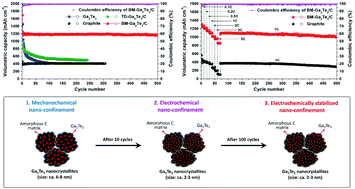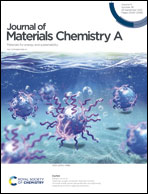Novel high-performance Ga2Te3 anodes for Li-ion batteries†
Abstract
The development of high-capacity and high-power lithium-ion batteries (LIBs) is a key challenge to meet the increasing demand for advanced mobile electronics and electric vehicles. A novel high-capacity and high-power Ga2Te3 anode material for LIBs, which exhibits a distinctive reaction mechanism with Li ions, has been introduced in this study. Two types of Ga2Te3/C composite were prepared via different synthetic routes, namely carbon thermal decomposition (TD) and high-energy ball milling (BM), to improve the electrochemical performance of Ga2Te3 anodes, and their electrochemical performances were compared. The electrochemical evaluation results indicate that the Ga2Te3/C composite produced by BM (BM-Ga2Te3/C) showed better electrochemical performance by delivering much smaller Ga2Te3 nanocrystallites than the Ga2Te3/C composite produced by TD (TD-Ga2Te3/C). Furthermore, the BM-Ga2Te3/C anode showed a highly reversible initial volumetric capacity (1245 mA h cm−3), stable capacity retention (93.2% after 500 cycles), and excellent high-rate performance (∼1000 mA h cm−3 at 1C after 500 cycles). These high electrochemical performances, which were demonstrated via ex situ analyses, were attained by a unique three-step nano-confinement process of Ga2Te3 in BM-Ga2Te3/C. Thus, this study provides a new material development strategy of employing mechano- and electro-chemical nano-confinement processes to develop high-performance anodes for LIBs.



 Please wait while we load your content...
Please wait while we load your content...